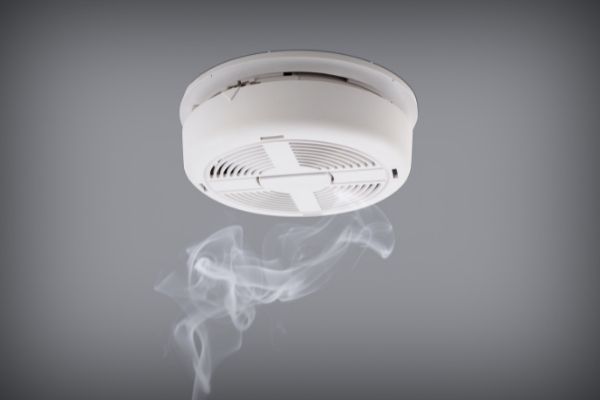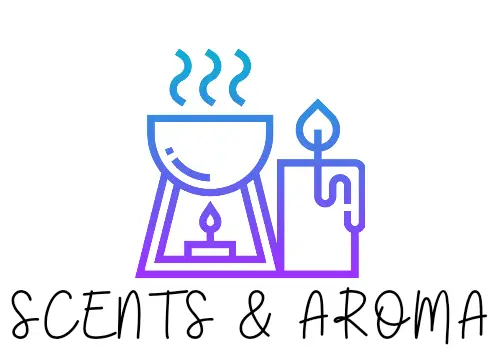Yes, candles could set off smoke alarms but this is very rare. Generally, a candle cannot produce enough smoke to set off a smoke alarm. However, when you light many candles in a room, close to the smoke detector, and blow them out all at once, you might just trigger the alarm system.
In this article, we would see if candles can set off smoke alarms, why candles don’t set off smoke alarms, tips for using your candle to avoid it triggering your smoke alarm, and how to put out your candle without producing smoke.

WILL A SCENTED CANDLE SET OFF A SMOKE ALARM?
Candles, whether scented or unscented (the scent really has nothing to do with this) cannot set off smoke alarms. Though, this could happen on rare occasions. However, besides a few possible situations, candles cannot set off smoke alarms.
It’s possible that your candle could set off a smoke alarm if you light it directly under the smoke detector. Blowing out the candle would cause the smoke to go directly to the smoke detector which causes the ascending smoke to trigger the alarm system.
Also, lighting too many candles in a room close to the smoke detector could be another reason your candle will set off the smoke alarm. Especially when putting out the candle, it produces more smoke. Imagine having five candles very close to the smoke detector, and you blow them out all at once. The cumulative smoke might surely be enough to set off the smoke alarm. You definitely don’t want to be raising false alarms do you?
WHY DON’T CANDLES SET OFF SMOKE ALARMS?
Well, to answer this question, we need to first know how the smoke alarm system works. So what’s a smoke alarm?
The smoke alarm system is created to be set off when the smoke detector detects particles in the air that signal the presence of smoke. There are two common types of smoke detectors; ionized and photoelectric detectors.
The ionized detector uses a small safely shielded radioactive material (most of its radiation is blocked inside the device so it’s safe) that ionizes particles. When particles enter the detector, they attract the ions and carry them away, reducing the current. When there are enough particles to reduce the current below a particular level, the detector will register those particles as smoke, and set off.
On the flip side, the photoelectric detector detects light that is reflected off particles from a light beam inside the sensing chamber of the detector. When there are particles present, and the amount of light registered reaches a certain point, the alarm goes off.
So why don’t candles set off smoke alarms?
Simply put, they do not release that much smoke to trigger the alarm system. As long as you are burning a candle in a ventilated room, the smoke wouldn’t gather. Also, if you put out your candle correctly, there’s barely any smoke thus, candles cannot set off smoke alarms.
The particles would not be enough to be detected as smoke particles. Most likely, the smoke might not even get to reach the smoke detector.
WHAT ARE THE TIPS FOR USING CANDLES TO AVOID SETTING OFF SMOKE ALARMS?
- Identify where smoke detectors are placed. When you find out where smoke detectors are, make sure you avoid lighting candles directly under them, or even close to them.
- Light candles in a ventilated room. Lighting candles where there’s poor ventilation is not only bad for health but would also make airflow slower, causing the smoke to accumulate.
- Turn the fan off. Putting the fan on when burning candles would increase smoke and would also make the smoke go up faster to the smoke detector.
- Do not light too many candles at once. The more the candle, the more the smoke so try not to light too many candles in a room. Another reason not to light to many candles at once is that candles produce small amounts of carbon monoxide.
- If you light more than one candle, put them out one at a time, instead of doing so at the same time.
- Do not blow out candles. When putting out candles, it is best not to blow them out as this will produce smoke. Instead, use tools like a candle snuffer or, wick dipper, to put them out.
HOW DO I PUT OUT A CANDLE WITHOUT PRODUCING SMOKE?
When you blow out candles with your mouth or you fan them out, the candle produces smoke, which might likely trigger the smoke alarm system. Here are better ways to put out a candle, and without producing smoke.
- USE A WICK DIPPER: The wick dipper is used to dip the wick of the candle into the wax. Since smoke is produced when the wick is blown out, doing this will prevent the wick from smoking as the wax will quench the flames effectively.
- USE A CANDLE SNUFFER: Candle snuffers are also called candle extinguishers. It’s shaped like a bell and attached to a thin post. To use a snuffer, you put it over the flame and it will extinguish it. The snuffer is more appropriate for thinner candles but if you are using a candle with more than one wick, extinguish one wick at a time.
- SUFFOCATE THE FLAME: Some candles that come in a glass or jar, come with lids, so one easy and smokeless way to put out the candle is to put the lid over the flame. If your candle doesn’t have a lid, you can find a lid to put over the flame.
- USE A SOOTLESS WAX: Not all waxes are created equally, some waxes such as paraffin wax produce which more harmful smoke. Look to buy cleaner burning waxes such as soy or beeswax. For more information on which was produces the least soot, check my guide.
CONCLUSION
Using candles is a delicate matter as there are many precautionary measures to take such as preventing your candle from setting off the smoke alarm. While we have concluded that candles do not generally set off smoke alarms, there are a few situations where they could, like blowing out a candle directly under the smoke detector.
Make sure to watch out for where you place your candles and how you put out the flames because these two factors will determine if or if not your candle will trigger the smoke alarm
- Can You Put Perfume In A Humidifier? (Read First) - September 17, 2022
- Can You Put Essential Oil In A Steam Mop? (Safety Advice) - September 17, 2022
- How To Make Lavender Oil At Home ( Candles And Diffusers) - September 9, 2022
